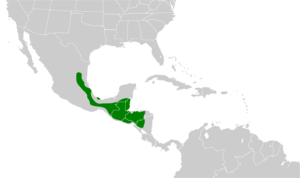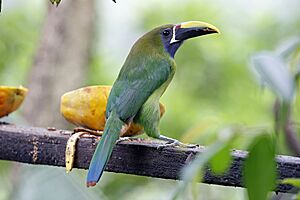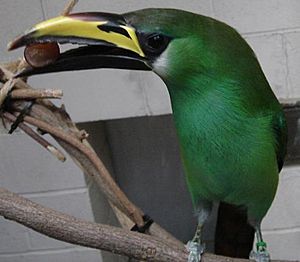Emerald toucanet facts for kids
Quick facts for kids Emerald toucanet |
|
|---|---|
 |
|
| Emerald toucanet (nominate group) | |
| Conservation status | |
| Scientific classification | |
| Genus: |
Aulacorhynchus
|
| Species: |
prasinus
|
| Subspecies | |
|
See text |
|
 |
|
| Synonyms | |
|
|
The emerald toucanet (Aulacorhynchus prasinus) is a colorful bird from the toucan family. These beautiful birds live in areas from Mexico all the way to Nicaragua. They are known for their bright green feathers and large, colorful beaks.
Contents
About the Emerald Toucanet
What is a Subspecies?
Scientists group living things into different categories. A species is a group of animals that can have babies together. Sometimes, a species can have smaller groups called subspecies. These groups are a bit different from each other, often because they live in different places.
The emerald toucanet has four main subspecies recognized by some bird experts:
- A. p. warneri
- A. p. prasinus (this is the main group, called the nominate subspecies)
- A. p. virescens
- A. p. volcanius
Scientists sometimes disagree on how to classify birds. For example, some experts used to think there were many more subspecies of the emerald toucanet. Now, many of those have been recognized as their own separate species. This shows how science is always learning and changing!
Appearance and Features
Like all toucans, the emerald toucanet is very colorful. It also has a large bill. Adult birds are usually about 29 to 37 centimeters (11 to 15 inches) long. They weigh between 150 to 240 grams (5.3 to 8.5 ounces).
Male and female emerald toucanets look very similar. However, females are usually a bit smaller and have shorter bills.
Their bill is quite striking. The bottom part (mandible) is black. The top part (maxilla) is yellow with a black spot near the nostrils. There is also a white stripe at the base of the bill.
Most of their feathers are green, which helps them blend in with the forest. Their underside is a bit lighter green than their back. The top of their head might have a bronze color. Their eyes are dark brown, surrounded by darker bare skin.
Their lower face and throat are white. The feathers under their tail are chestnut brown. The top of their tail starts green and turns blue towards the end. The tips of the tail feathers are also chestnut brown. Young toucanets are usually grayer than adults.
Where They Live
Emerald toucanets are found in different parts of Central America. Each subspecies lives in a specific area:
- A. p. warneri lives in southeastern Mexico.
- A. p. prasinus is found in eastern and southeastern Mexico, including the Yucatán Peninsula, Belize, and northern Guatemala.
- A. p. virescens lives from southeastern Mexico through Guatemala, El Salvador, and Honduras into northern Nicaragua.
- A. p. volcanius is found in eastern El Salvador.
These birds mostly live in humid montane forests, which are forests found in mountains. But you can also find them in more open areas. These include younger forests, shrublands, pastures, and even farms. They can live anywhere from near sea level up to about 3,000 meters (9,800 feet) high.
Behavior and Habits
Movement
Emerald toucanets do not migrate. This means they stay in the same general area all year round.
Social Life
These toucanets are social birds. They often gather in groups of up to 10 birds. This helps them find food and stay safe.
What They Eat
Emerald toucanets find their food by picking it off branches while perched. They eat a wide variety of things! Their diet includes many different kinds of fruits. They also eat insects and other small creatures without backbones. Sometimes, they even eat small animals with backbones, like other birds, eggs, lizards, and snakes.
Reproduction and Life Cycle
The breeding season for emerald toucanets is from March to July. They make their nests in holes in trees. These holes can be natural or left behind by woodpeckers. Their nests can be as high as 27 meters (89 feet) above the ground.
A female toucanet usually lays three or four eggs, but sometimes it can be one to five. Both the male and female birds take turns sitting on the eggs. However, the female spends more time incubating them. The eggs hatch after about 16 days. The young birds are ready to leave the nest 42 to 45 days after they hatch.
Sounds and Calls
The emerald toucanet makes a special sound that is like a nasal, barking "Wok!-Wok!-Wok!-Wok!-Wok!-Wok!-Wok!..." They also make a growling, throaty sound like "wra'a'a'a'a'a'ak".
Status and Protection
The IUCN (International Union for Conservation of Nature) has listed the emerald toucanet as a species of "Least Concern." This means that they are not currently in danger of disappearing.
They live across a very large area. However, the total number of emerald toucanets is not known. It is believed that their population is slowly decreasing. While there are no immediate major threats, they can be harmed by the destruction of their forest homes.
Emerald Toucanets and People
As Pets
The emerald toucanet is a popular pet bird. People who hand-feed them often find them to be very friendly. They enjoy playing and interacting with their owners. These toucanets can even learn tricks, much like cockatoos.
Because they are active birds, they need a large cage. This cage should have many perches for them to hop between. They also need a special diet that is high in fruit. If they don't get the right food, they can get a disease where too much iron builds up in their bodies. This is similar to a condition called hemochromatosis in humans.
See also
 In Spanish: Tucancito esmeralda para niños
In Spanish: Tucancito esmeralda para niños





